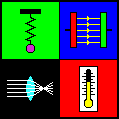
(Overview)
|
The speed of a moving body and its direction of movement remain constant according to Newton's first law (law of inertia) if no force acts on it. The circumstances of a circular motion are different: In this case there must be a force, the so-called centripetal force, which is directed to the axis of rotation. This simplified model of a carousel demonstrates this force.
If you choose the second one of the four radio buttons on the top right, the vector arrows of the exerted forces will be drawn for each of the eight pendulum masses: the weight force will be painted black, the force exerted by the string blue. Addition of these vectors results in the net force (red) which is identical with the mentioned inward pointing centripetal force.
In addition to the simulation of the carousel (with force arrows or without them) the program offers a simple two-dimensional sketch of the force vectors and important numerical values of the circular motion.
If you want to observe exactly the force arrows, you can stop the rotation by using the "Pause / Resume" button or make it ten times slower with the option "Slow motion". The text fields make it possible to vary the parameters within certain limits (don't forget to press the "Enter" key!).
Note: The simulation assumes a circular motion with constant angular velocity; the proceedings while the masses are accelerated respectively slowed down are not taken into consideration. The effects of air resistance are neglected, too.
 |
| Physics Applets (Overview) |
URL: http://www.walter-fendt.de/ph11e/carousel.htm
© Walter Fendt, March 10, 1999
Last modification: December 27, 2002